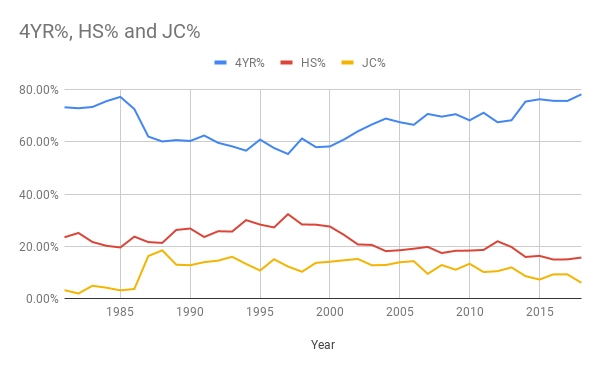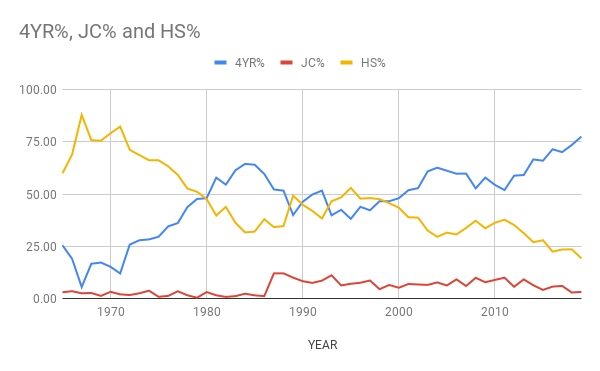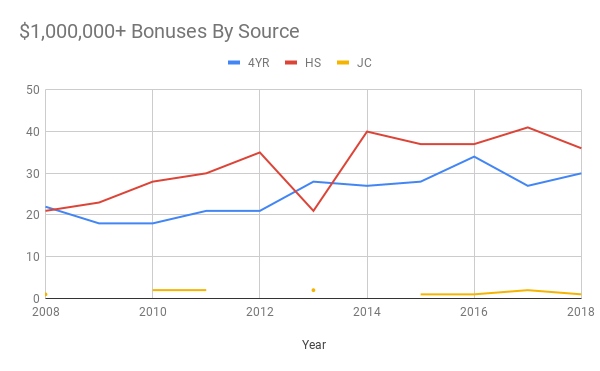Draft System Has Pushed Teams To Pick More College Players


The 2019 MLB draft reinforced that teams are prioritizing college players at a higher level than ever before.
Fifty-one of the 78 total selections on the first day of this year’s draft came out of four-year college programs, or roughly 65.4 percent of the pre-third round draft pool. That is the second-highest rate of four-year players selected in that portion of the draft. Only the 1981 draft (69.2 percent) is higher, and that was at a time when junior college players were selected in a separate January draft.
But it’s not just the top of the draft in which teams have begun prioritizing and drafting college players. It’s throughout the top 10 rounds, and it’s through the entirety of Day 3 as well.
Since the late 1990s there’s been a steadily increasing trend of teams selecting more and more college players, and it comes at the expense of the high school and junior college prospects. That’s true of drafted players overall, as well as players who are drafted and signed.

The chart above shows the percentage of players drafted and signed from 1981-2018. There was a dip in the four-year signing percentage in the late 1980s, once the January draft was eliminated in 1987 and more junior college players were taken in the June draft.
Since the 1981 draft, approximately two-thirds of all drafted players who have signed contracts have been products of four-year colleges and universities. (This data excludes the 2019 draft class, since we don’t yet know who will sign.) High school players make up about 22 percent, and the remaining 11.4 percent consists of JuCo players.
In the last five drafts, the percentage of signed draftees coming out of four-year schools has ranged from 75.5 to 78.3 percent. The 2015 draft saw 715 college players sign contracts, the most of any draft from 1981 to 2018, despite that year’s draft only having the fifth-most total signees in that same time frame.
There are a number of reasons for this trend. Multiple teams have told Baseball America that they are more prone to pass on high school pitchers at the top of the draft because of the recent struggles of that demographic. And teams have a much more robust dataset for college players thanks to a deeper statistical resume and troves of analytical data from Trackman, etc., to a depth that isn’t possible to acquire with high school players. Both of those reasons can push teams to take more college players. The increase in college players taken in the first two rounds this year would seem to indicate there is something to this trend.
But there’s another reason that is also speeding up the trend. The current draft system has created an environment that leads teams to sign college players instead of high school players. There’s an obvious jump in the percentage of college players that occurs in 2012, which accounts for the current CBA in which teams aggressively take college seniors in rounds six through 10 in order to create more financial flexibility under the current slotting system.
The chart below shows the percentage of players drafted from each source among the top 10 rounds, including data from the 2019 class.

Maybe more importantly for the trend lines, that 2012 draft was the first time that teams were unable to spend freely on Day 3. Under the previous draft systems, if the Reds wanted to give basketball player Amir Garrett $1 million to sign in the 22nd round or the Orioles wanted to hand Zach Davies $575,000 as a 26th rounder, they could and did so. Garrett would have been an extremely risky early-round pick—there was no guarantee he would sign and he hadn’t even played competitive baseball during his senior year of high school. But the Reds were able to spend money, while also spending very little draft capital (only a 22nd-round pick in 2011).
It would be nearly impossible to sign Garrett in a similar situation now, as finding $1 million or more to spend in the late rounds of the draft requires saving significant money on bonuses in the top 10 rounds. In 2011, there were three high school players who received $1 million or larger bonuses after the 10th round. Since then, there have been only two in the past six drafts combined (Chad McClanahan and Cameron Planck, a pair of 11th-rounders in the 2016 draft).
The 2011 draft was the last year of the old draft system with no upper limit on what teams could spend. In 2011, there were 50 high school players drafted in the top three rounds who received a bonus of $500,000 or more to sign. There were an additional 26 high school players drafted after the third round who received $500,000 or more, including 21 taken in the fifth round or later and 11 taken after the 10th round. The 2011 draft was a free-spending one. Every team was aware that new, harsher spending limits were likely to arrive in 2012, so teams opened up their checkbooks. But moving back to 2010, there were 63 high school draftees who signed for $500,000 or more, including 18 from the fifth round on.
The 2012 draft is the point where a hard limit on how much teams can spend on their draft classes (unless they were willing to lose future draft picks) made it more difficult for teams to sign high school players, who generally have the highest asking prices because of higher leverage. A high school draftee can be drafted as many as five additional times (by attending junior college for two years followed by a redshirt year at a four-year college and two additional years). A four-year college junior’s choices are to either sign or go back to school for a final year of eligibility, which ensures a usually well below-market value offer the next year as a college senior with no remaining eligibility.
In 2018, even with nearly a decade’s worth of inflation pushing up bonuses, there were only 58 high school players who received $500,000 or larger bonuses. Under the new draft format, teams have averaged signing 59 high school players for $500,000 or more per draft.

If we saw a massive increase in the number of college players receiving large bonuses, it would indicate a shift in team’s drafting philosophies more than a change brought on by different draft rules. But we are not seeing that. What’s happened is that teams are signing a lot more college players who mostly are signing for bonus amounts that will not entice top high school players to give up their college commitments.
At the top of the draft, high school players are getting paid as much if not more than they did a decade ago. Last year, 36 high school players received contracts of $1 million or more compared to 30 four-year college draftees. In nine of the past 10 drafts, there have been more high school players who received $1 million or larger bonuses than four-year college players. In the final four years of the previous system, 43 percent of players receiving $1 million or larger bonuses were four-year college players. Under the current system, that has increased only one percent to 44 percent.

Dropping that number to $500,000 sees a modest increase in the number of college players landing those bonuses compared to high school players, but generally roughly the same number of high school and four-year college players receive bonuses of $500,000 or more. Under the last four years of the previous system, 39 percent of $500,000-plus bonuses went to four-year college players. Under the current draft system, it’s 44 percent.
What has changed is teams are signing many more college players for less than $500,000. Many high school players with solid college options are reticent for sign for less than that amount. So that has led to a significant increase in the percentage of college draftees and college signees in the draft.
In the past, teams knew that while they would have to spend significant money to land a projectable high school player, in many cases the second wave of top high school players would fall late in the draft. Teams could spend money but little in terms of draft capital to land those players. But under the current format, where spending more than $500,000 on any player taken after the middle of the fourth round means going above slot for that pick and taking money from elsewhere in the team’s draft pool, teams generally have to spend both money and a relatively high draft pick to land a second-tier prep prospect. By the end of the fifth round, the draft shifts focus to a very college-heavy approach.
So some of the current shift may result from a different approach. But the larger picture is that top high school players are generally looking to receive large signing bonuses out of high school to buy out their chances to play in college. Under the current system, it has become much more difficult to do so. And by doing so, the current system has led to a stronger emphasis on drafting college players.


Comments are closed.